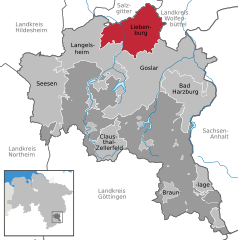Dörnten
| Liebenburg | ||
|---|---|---|
 |
||
|
||
| Coordinates: 52°01′27″N 10°26′02″E / 52.02417°N 10.43389°ECoordinates: 52°01′27″N 10°26′02″E / 52.02417°N 10.43389°E | ||
| Country | Germany | |
| State | Lower Saxony | |
| District | Goslar | |
| Government | ||
| • Mayor | Alf Hesse (SPD) | |
| Area | ||
| • Total | 78.73 km2 (30.40 sq mi) | |
| Elevation | 128 m (420 ft) | |
| Population (2015-12-31) | ||
| • Total | 8,059 | |
| • Density | 100/km2 (270/sq mi) | |
| Time zone | CET/CEST (UTC+1/+2) | |
| Postal codes | 38704 | |
| Dialling codes | 05346 | |
| Vehicle registration | GS | |
| Website | www.liebenburg.eu | |
Liebenburg is a municipality in the district of Goslar, in Lower Saxony, Germany.
The municipal area is situated north of the Harz mountain range, within the eastern Salzgitter Hills of the Innerste Uplands. It borders on the district capital Goslar, approx. 12 km (7.5 mi) in the south; the adjacent municipalities in the north are Salzgitter-Bad and Schladen in Wolfenbüttel District.
The municipality comprises Liebenburg proper (with 2,308 inhabitants) and the following nine villages, which were incorporated on 1 July 1972:
Archaeological excavations of a gallery grave indicate a settlement of the area in the Late Neolithic. The former Saxon estates in 1235 belonged to the territory of the newly established Prince-Bishopric of Hildesheim.
From 1292 to 1302, Prince-bishop Siegfried II of Querfurt had the Levenborch spur castle erected in the Salzgitter Hills, near where his episcopal lands bordered on the Principality of Brunswick-Wolfenbüttel. From 1366 it was pawned by his successors to the citizens of Braunschweig, important to secure the trade route to the Imperial City of Goslar.
The castle was seized by the warlike duke Henry V of Brunswick-Wolfenbüttel after the Hildesheim Diocesan Feud in 1523 and temporarily served as hidden residence of his mistress Eva von Trott. The Catholic duke in turn lost it to the Protestant Schmalkaldic League, whose troops campaigned the Brunswick lands from 1542 until their final defeat in the 1547 Battle of Mühlberg. During the Thirty Years' War, the stronghold was used as headquarters by the Imperial Generalissimo Albrecht von Wallenstein in 1625, it was occupied by Swedish troops in 1633, and reconquered by the Imperial Army in 1641.
...
Wikipedia




